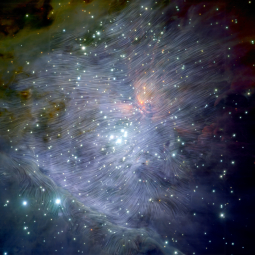By David Chuss and Ralph Y. Shuping
Paper:
HAWC+/SOFIA Multiwavelength Polarimetric Observations of OMC-1
Chuss, David T., et al., 2019/02, ApJ, 872, 187.
One of the fundamental links in the chain of our origin story is the formation of stars and planets out of the interstellar gas and dust that exist in both our own Milky Way Galaxy and in other galaxies. Stars form when these interstellar clouds of gas and dust collapse under their own gravity. However, simple gravitational collapse predicts a galactic star formation rate that is much higher than actually observed. It is thought that this inefficiency is at least partially due to magnetic fields that support the interstellar clouds against collapse; but establishing the role of magnetic fields in the star formation process has been difficult due to limitations in available instrumentation.
Luckily, magnetically aligned interstellar dust grains emit polarized light at far-infrared wavelengths. Hence, far-IR polarization can be used as a proxy for the magnetic field strength and direction in interstellar clouds. The SOFIA HAWC+ instrument is one of only a few far-IR polarimeters that astronomers can use to probe astronomical magnetic fields. The high spatial resolution provided by the 106-inch (2.7-meter) diameter SOFIA telescope and increased sensitivity over previous instruments make HAWC+ the perfect tool to address the role of magnetic fields in the star formation process.
“HAWC+ and SOFIA have a unique and important role in the study of magnetic fields,” noted Darren Dowell, the HAWC+ principal investigator at the Jet Propulsion Laboratory. “They combine the angular resolution needed to see detail in the turbulent magnetic fields and the wavelength coverage required to highlight different components of the nearby clouds.”
In order to address the role of magnetic fields in star forming clouds, David Chuss from Villanova University and collaborators have obtained HAWC+ observations of the Orion Nebula, which is often used as an archetype or “Rosetta Stone” for understanding high-mass clustered star formation throughout the galaxy. The polarimetry observations have produced some of the most detailed magnetic field line maps to date, with spatial scales of ~0.01 parsecs (53-micron band). Such resolution enables the mapping of the field within the cores of the clouds where the later stages of the star formation process occurs. These observations confirm previous results showing that magnetic fields do in fact help regulate the star formation process in dense interstellar clouds.
The high-resolution polarimetry maps have produced two additional interesting results. The first pertains to the process by which the dust grains become aligned. The grain-alignment mechanism is the subject of great interest both because it provides the basis for the measurements of magnetic fields and because it provides key, testable insights into the physics of the dust and its environs. The current leading theory posits that anisotropic radiation fields are an important ingredient for the alignment of the grains with the magnetic field. In other clouds, it has been observed that grain alignment efficiency degrades in the cores of clouds, presumably where the grains are shielded from the interstellar radiation field. However, in Orion Molecular Cloud 1 (OMC-1), these results show no evidence that the efficiency of this alignment process falls off in dense regions. This is likely due to the nature of the strong radiation field present within the OMC-1 clouds, presumably due to the young stars themselves.
A second result is that the magnetic field traces the “explosive outflow” emanating from the heart of the OMC-1. This explosion of material was likely caused 500–1,000 years ago by an interaction of several stars after the orbital decay of a protostellar star system.
“Explosive outflows indicate violent interactions which may terminate accretion, set stellar masses, and help establish the initial mass function,” explains Professor John Bally of the University of Colorado at Boulder and a co-investigator on the HAWC+ OMC-1 observations. “Explosive outflows, in conjunction with runaway stars, demonstrate that dynamical interactions in such groups are an important ingredient in star formation.”
Near the center of the explosion, the magnetic fields are overwhelmed by the energetics of the explosion; however, farther out, the kinetic energy is weaker and it appears that the magnetic fields are guiding the ejecta. The magnetic field measurements provide valuable constraints on the energetics of this unique outflow.
These results for Orion are powerful examples of the utility of SOFIA-HAWC+ in understanding magnetic fields in star forming clouds. Future results will continue to advance our understanding of the role of magnetic fields in the interstellar medium in general, and in the star formation process in particular.
“It has been thrilling to have a front row seat to the teamwork needed to accomplish these observations,” added Dowell. “I look forward to discovering whether Orion is the exception or the rule in other galactic clouds.”
